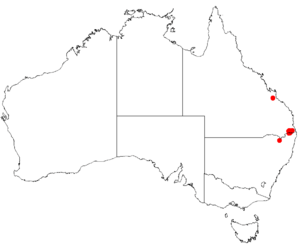Acacia acrionastes facts for kids
Quick facts for kids Acacia acrionastes |
|
|---|---|
| Scientific classification | |
| Genus: |
Acacia
|
| Species: |
acrionastes
|
 |
|
| Occurrence data from AVH | |
Acacia acrionastes is a special kind of shrub or small tree. It belongs to a large group of plants called Acacias, which are often found in Australia. This plant is known for its tall, thin shape and smooth bark.
What Does It Look Like?
This plant can grow quite tall, usually between 1.5 and 8 meters (about 5 to 26 feet) high. It has a rather thin, "spindly" look, meaning it's not very bushy. Its bark is smooth to the touch.
Instead of typical leaves, Acacia acrionastes has what are called phyllodes. These are flattened leaf stems that act like leaves. They are long and narrow, measuring about 6 to 17 centimeters (2.4 to 6.7 inches) in length and 2 to 4 millimeters (0.08 to 0.16 inches) in width. They can be straight or slightly curved.
When it's time to bloom, usually in July and August, this plant produces creamy yellow flowers. These flowers grow in clusters called inflorescences.
Where Does It Grow?
You can find Acacia acrionastes in eastern Australia. It is quite common in Queensland, but it is considered rare in north-western New South Wales.
This plant prefers to grow in specific types of environments. It is often found in dry sclerophyll forests. These are forests with tough, hard-leaved trees that can handle dry conditions. It also likes to grow in loamy clay soils, which are soils that have a good mix of sand, silt, and clay. These soils are usually found over volcanic rock.
How Was It Discovered?
The Acacia acrionastes was first officially described by a botanist named Leslie Pedley. This happened in 1990. He wrote about it in an article titled Acacia acrionastes (Leguminosae: Mimosoideae), a new species from south-eastern Queensland. This article was published in a science journal called Austrobaileya.
Sometimes, this plant is also known by another scientific name, Racosperma acrionastes. It can also be easily confused with a closely related plant called Acacia adunca.
See also
 In Spanish: Acacia acrionastes para niños
In Spanish: Acacia acrionastes para niños

